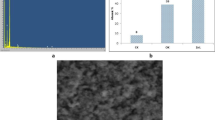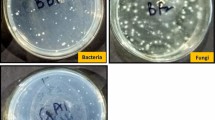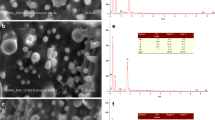Abstract
Zinc oxide nanoparticles (ZnONP) were synthesized and characterized using SEM, EDAX, DLS and UV–Vis spectra. Its use as a nanofertilizer as an alternative to conventional zinc sulphate (ZnSO4.7H2O) was evaluated in five Zn-deficient soils with a variable pH range (7.2–8.7). For this, the carbon of the soil microbial biomass (SMBC), the bacterial population, the nutrient dynamics and the biometric parameters of the wheat crop were assessed. The varying dosages (0, 100, 200 and 500 mg/L), sizes (30–100 nm), and the spherical shape of ZnONPs were evaluated in comparison to ZnSO4.7H2O levels. Results showed the maximum SMBC and bacterial population at 100 mg/L of ZnONPs but a sharp decline at higher concentrations. In addition, soil application of ZnONPs at 5 mg/kg produced a higher root elongation (4.3–8.8%), shoot elongation (3.5–4.0%), total chlorophyll (4.9–5.6%), grain yield (1.7–2.3%) and grain Zn-content (1.6–2.1%) in comparison to the conventional ZnSO4.7H2O at 10 mg/L. ZnONPs at 100 mg/L produced a higher soil microbial biomass carbon (3.9–4.6%), bacterial population (7.2–9.0%), germination (22%) and grain Zn-content (17.9–20%) as compared to the conventional ZnSO4.7H2O at 0.5%. The higher grain Zn-contents could be attributed to the small size and high surface area of ZnONPs resulting in easy entry into the plant system either through root or foliar by penetrating the pores present in the cell membranes. Conversely, the conventional ZnSO4.7H2O, due to its larger size and higher solubility as compared to ZnONPs, has low retention in plant systems, high surface run-off and low fertilizer efficiency. Thus, the authors concluded to apply spherically synthesized ZnONPs (average size-36.7 nm) at 5 mg/kg in the soil application and 100 mg/L in the foliar application for maintaining SMBC and bacterial population, improving total chlorophyll, and grain Zn-contents and overall sustaining wheat production in Zn-deficient neutral and alkaline soils.








Similar content being viewed by others
References
Abdul-Baki AA, Anderson JD (1973) Vigor determination in soybean seed by multiple criteria. Crop Sci 13(6):630–633
Aditya A, Chattopadhyay S, Jha D, Gautam HK, Maiti S, Ganguli M (2018) Zinc oxide nanoparticles dispersed in ionic liquids show high antimicrobial efficacy to skin-specific bacteria. ACS Appl Mater Interfaces 10(18):15401–15411. https://doi.org/10.1021/acsami.8b01463
Alamdari S, Ghamsari MS, Lee C, Han W, Park HH, Tafreshi MJ, Afarideh H, Ara MHM (2020) Preparation and characterization of Zinc oxide nanoparticles using leaf extract of Sambucus ebulus. Appl Sci 10:3620. https://doi.org/10.3390/app10103620
Arnon DI (1949) Copper enzymes in isolated chloroplasts Polyphenoloxidase in Beta vulgaris. Plant Physiol 24(1):1–15
Awasthi A, Bansal S, Jangir LK, Awasthi G, Awasthi KK, Awasthi K (2017) Effect of ZnO nanoparticles on Germination of Triticum aestivum Seeds. Adv Soft Mater 376(1):1700043. https://doi.org/10.1002/masy.201700043
Bailey VL, Smith JL, Bolton H Jr (2007) Substrate-induced respiration and selective inhibition as measures of microbial activity in soils. In: Carter MR, Gregorich EG (eds) Soil sampling and methods of analysis. CRC Press, Boca Raton, p 30
Cakmak I (2008) Enrichment of cereal grains with zinc: agronomic or genetic biofortification? Plant Soil 302(1–2):1–17
Chhonkar PK, Bhadraray S, Patra AK, Purakayastha TJ (2007) Experiments in soil biology and biochemistry. Westville Publishing House, New Delhi
Dapkekar A, Deshpande P, Oak MD, Paknikar KM, Rajwade JM (2018) Zinc use efficiency is enhanced in wheat through nanofertilization. Sci Rep 8:6832. https://doi.org/10.1038/s41598-018-25247-5
Doolette CL, Read TL, Howell NR, Cresswell T, Lombi E (2020) Zinc from foliar-applied nanoparticle fertiliser is translocated to wheat grain: a 65Zn radiolabelled translocation study comparing conventional and novel foliar fertilisers. Sci Total Environ 749:142369. https://doi.org/10.1016/j.scitotenv.2020.142369
Elemike EE, Uzoh IM, Onwudiwe DC, Babalola OO (2019) The role of nanotechnology in the fortification of plant nutrients and improvement of crop production. Appl Sci 9:499. https://doi.org/10.3390/app9030499
García-López JI, Niño-Medina G, Olivares-Sáenz E, Lira-Saldivar RH, Barriga-Castro ED, Vázquez-Alvarado R, Rodríguez-Salinas PA, Zavala-García F (2019) Foliar application of Zinc oxide nanoparticles and Zinc sulfate boosts the content of bioactive compounds in Habanero peppers. Plants 8:254. https://doi.org/10.3390/plants8080254
Gomez A, Narayan M, Zhao L, Jia X, Bernal RA, Lopez-Moreno ML, Peralta-Videa JR (2021) Effects of nano-enabled agricultural strategies on food quality: current knowledge and future research needs. J Hazard Mater 401:123385. https://doi.org/10.1016/j.jhazmat.2020.123385
Gupta R (2015) Guidelines for use of micronutrients, soil ameliorants and integrated nutrient management practices in NFSM States. New Delhi: Ministry of Agriculture Government of India, pp 11–12. https://www.farmer.gov.in/imagedefault/handbooks/BooKLet/DELHI/20150515220851Micronutrient.pdf.
Hayat K, Gondal MA, Khaled MM, Ahmed S, Shemsi AM (2011) Nano ZnO synthesis by modified sol gel method and its application in heterogeneous photocatalytic removal of phenol from water. Appl Catal A 393(1–2):122–129
Hong J, Wang L, Sun Y, Zhao L, Niu G, Tan W, Rico CM, Peralta-Videa JR, Gardea-Torresdey JL (2016) Foliar applied nanoscale and microscale CeO2 and CuO alter cucumber (Cucumis sativus) fruit quality. Sci Total Environ 563:904–911
Iqbal MA (2019) Nano-fertilizers for sustainable crop production under changing climate: a global perspective. Sustainable crop production (Book Chapter). IntechOpen, Rijeka. https://doi.org/10.5772/intechopen.89089
Ishwarya R, Vaseeharan B, Kalyani S et al (2018) Facile green synthesis of zinc oxide nanoparticles using Ulva lactuca seaweed extract and evaluation of their photocatalytic, antibiofilm and insecticidal activity. J Photochem Photobiol B Biol 178:249–258
Jensen HL (1942) Nitrogen fixation in leguminous plants II: is symbiotic nitrogen fixation influenced by Azotobacter. Pro Line Soc NSW 57:205–212
Jiang H, Wang H, Yang B, Cao X, Liu X (2020) Effects of ZnO nanoparticles on microbial biomass and enzyme activity in soils containing cellulose and lignin. E3S Web Conf 194:5028. https://doi.org/10.1051/e3sconf/202019405028
King EO, Ward MK, Raney DE (1954) Two simple media for the demonstration of pyocyanin and Fuorescin. J Lab Clin Med 44:301–307
Kumar C, Mani D (2010) Enrichment and management of heavy metals in sewage irrigated soil. Academic Publishing AV Akademikerverlag GmbH and Co. KG, Germany, pp 1–123 (ISBN No. 978-3-8383-9893-8)
Lin D, Xing B (2008) Root uptake and phytotoxicity of ZnO nanoparticles. Environ Sci Technol 42(15):5580–5585
Mariya A, Kumar C, Masood M, Kumar N (2019) The pristine nature of river Ganges: its qualitative deterioration and suggestive restoration strategies. Environ Monit Assess 191:542. https://doi.org/10.1007/s10661-019-7625-7
Mazumder JA, Khan E, Perwez M, Gupta M, Kumar S, Raza K, Sardar M (2020) Exposure of biosynthesized nanoscale ZnO to Brassica juncea crop plant Morphological, biochemical, and molecular aspects. Sci Rep 10:8531. https://doi.org/10.1038/s41598-020-65271-y
Mikula K, Izydorczyk G, Skrzypczak D, Mironiuk M, Moustakas K, Witek-Krowiak A, Chojnacka K (2020) Controlled release micronutrient fertilizers for precision agriculture–A review. Sci Total Environ 712:136365. https://doi.org/10.1016/j.scitotenv.2019.136365
Nibin PM, Ushakumari K, Ishrath PK (2019) Organic nano NPK formulations on soil microbial and enzymatic activities on post harvest soil of Bhindi. Int J Curr Microbiol App Sci 8(4):1814–1819
Pavithra N, Lingaraju K, Raghu G, Nagaraju G (2017) Citrus maxima (pomelo) juice mediated eco-friendly synthesis of ZnO nanoparticles: applications to photocatalytic, electrochemical sensor and antibacterial activities. Spectrochim Acta A2017(185):11–19
Pikovskaya RI (1948) Mobilization of phosphorous in soil in connection with vital activity of some microbial species. Microbiologiya 17:362–370
Poornima R, Koti RV (2019) Effect of nano zinc oxide on growth, yield and grain zinc content of sorghum (Sorghum bicolor). J Pharmacogn Phytochem 8(4):727–731
Rashid MI, Shahzad T, Shahid M, Ismail IMI, Shah GM, Almeelbi T (2017) Zinc oxide nanoparticles affect carbon and nitrogen mineralization of Phoenix dactylifera leaf litter in a sandy soil. J Hazard Mater 324:298–305
Sabir S, Zahoor MA, Waseem M, Siddique MH, Shafique M, Imran M, Hayat S, Malik IR, Muzammil S (2020) Biosynthesis of ZnO nanoparticles using Bacillus subtilis: characterization and nutritive significance for promoting plant growth in Zea mays L. dose-response. Dose Response 18(3):155932582095891. https://doi.org/10.1177/1559325820958911
Seeley HW, Van De Mark PJ, Lee JJ (1991) Microbes in action: a laboratory manual of microbiology, 4th edn. W.H Freeman and Co., Gordonsville
Seyed-Sharifi R, Khalilzadeh R, Pirzad A, Anwar S (2020) Effects of biofertilizers and Nano Zinc-Iron oxide on yield and physicochemical properties of wheat under water deficit conditions. Commun Soil Sci Plant Anal 51(19):2511–2524
Shen Z, Chen Z, Hou Z, Li T, Lu X (2015) Ecotoxicological effect of zinc oxide nanoparticles on soil microorganisms. Front Env Sci Eng 9(5):912–918
Singh D, Chhonkar PK, Dwivedi BS (2005) Manual on soil, plant and water analysis. Westville Publishing House, New Delhi, p 200
Singh K, Madhusudanan M, Ramawat N (2019) Synthesis and characterization of zinc oxide nanoparticles (ZnONPs) and their effect on growth, Zn content and yield of rice (Oryza sativa L.). Journal of Multidisciplinary Engineering Science and Technology (JMEST), ISSN: 2458–9403 Vol. 6 Issue 3, www.jmest.org JMESTN42352879 9750
Srivastav AK, Kumar M, Ansari NG, Jain AK, Shankar J, Arjaria N, Jagdale P, Singh D (2016) A comprehensive toxicity study of zinc oxide nanoparticles versus their bulk in wistar rats: toxicity study of zinc oxide nanoparticles. Hum Exp Toxicol 35(12):1286–1304
Tarafder C, Daizy M, Alam MM, Ali MR, Islam MJ, Islam R, Ahommed MS, Aly MAS, Khan MZH (2020) Formulation of a hybrid Nanofertilizer for slow and sustainable release of micronutrients. ACS Omega 5(37):23960–23966
Tekrony DM (2003) Precision is an essential component in seed vigour testing. Seed Sci Technol 31(2):435–447
Tshabalala M, Dejene B, Swart H (2012) Synthesis and characterization of ZnO nanoparticles using polyethylene glycol (PEG). Phys B Condens Matter 407:1668–1671
Yadav RC, Patra AK, Purakayastha TJ, Singh R, Kumar C (2014) Effect of engineered nanoparticles of Fe and Zn oxides on enzyme activity and bacterial abundance in soil at ambient and elevated atmospheric CO2. Proc Natl Acad Sci India Sec B Biol Sci 84(3):649–656
Waksman SA (1922) A method for counting the number of fungi in the soil. J Bacteriol 7:339–341
Yusefi-Tanha E, Fallah S, Rostamnejadi A, Pokhrel LR (2020) Zinc oxide nanoparticles (ZnONPs) as a novel nanofertilizer: influence on seed yield and antioxidant defense system in soil grown soybean (Glycine max cv. Kowsar). Sci Total Environ 738:140240. https://doi.org/10.1016/j.scitotenv.2020.140240
Acknowledgements
The authors acknowledge the Department of Science and Technology (DST) for granting the project entitled “Improvement in zinc micronutrient delivery for cereal crops employing engineered nanoparticles” [DST File No. SR/NM/NS-1109/2015(G)]. They are also grateful to Dr. Jagriti Narang, Amity Institute of Nanotechnology, and Dr. Amit C. Kharkwal, Amity Institute of Technology, AUUP, for their valuable guidance and support.
Author information
Authors and Affiliations
Contributions
Kuldeep Singh (KS), Mukil Madhusudanan (MM), and Naleeni Ramawat (NR) designed and performed the work. KS, AKV, NR, and Chitranjan Kumar (CK) wrote the original manuscript after completion of a project work [DST File No. SR/NM/NS-1109/2015(G)]. KS, AKV, NR, and CK substantially revised and edited the manuscript.
Corresponding author
Ethics declarations
Conflict of interest
The corresponding author declares that there is no conflict of interest among all authors to publish this manuscript in this journal.
Supplementary Information
Below is the link to the electronic supplementary material.
Rights and permissions
About this article
Cite this article
Singh, K., Madhusudanan, M., Verma, A.K. et al. Engineered zinc oxide nanoparticles: an alternative to conventional zinc sulphate in neutral and alkaline soils for sustainable wheat production. 3 Biotech 11, 322 (2021). https://doi.org/10.1007/s13205-021-02861-1
Received:
Accepted:
Published:
DOI: https://doi.org/10.1007/s13205-021-02861-1




